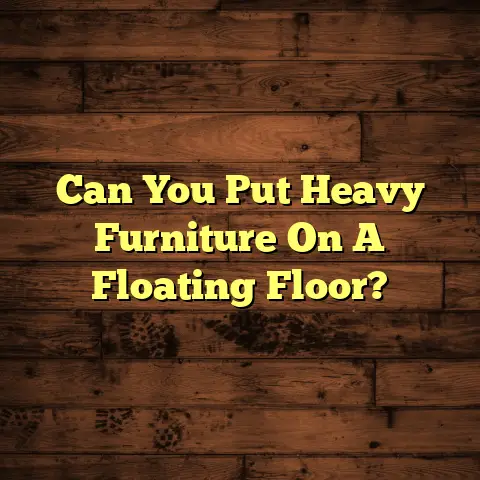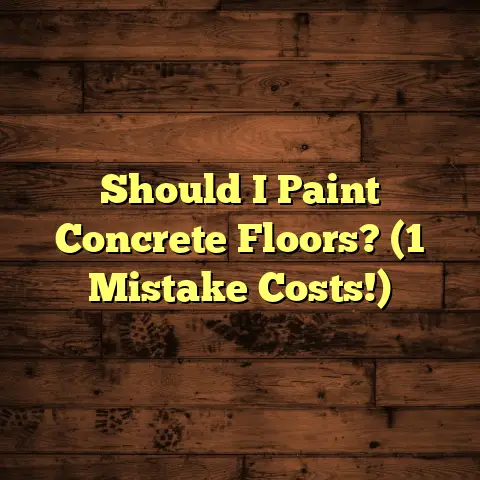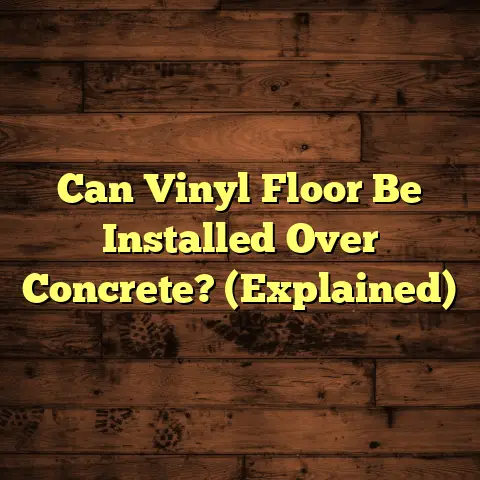Vacuuming Vinyl Plank: Yes or No? (5 May Break It!)
Let’s kick things off with a little story.
Picture this: My buddy Dave, a self-proclaimed “Cleanliness Crusader,” decided his vinyl plank floors needed some serious attention.
He donned a bright yellow rubber suit, grabbed his industrial-strength vacuum, and declared war on dust bunnies.
“Fear not, dirt!” he yelled, channeling his inner superhero. “The Vacuum Avenger is here!”
The noise was deafening, the floors… well, let’s just say they weren’t thrilled.
So, that brings us to the burning question: Can you vacuum vinyl plank flooring, or are you signing up for a cleaning catastrophe?
Let’s dive in and find out!
Section 1: Understanding
Vinyl Plank Flooring
What is Vinyl Plank Flooring?
Vinyl plank flooring (VPF) has become a total rockstar in the flooring world, and for good reason.
It’s basically a multi-layered synthetic floor that mimics the look of real wood or stone, but with some serious advantages.
Think of it as the superhero of flooring:
-
Durable: It can handle a beating, resisting scratches, dents, and stains better than many other options.
-
Water-Resistant: Spilled juice? No sweat! VPF laughs in the face of moisture, making it perfect for kitchens and bathrooms.
-
Aesthetic Appeal: Seriously, you can find VPF that looks just like your dream hardwood.
It comes in a million styles and colors, so you’re sure to find something you love.
The core of VPF is usually made of PVC, and it’s topped with a wear layer that protects the design and keeps it looking good.
Installation is also a breeze – many types click together, making it a DIY dream!
The Rise of Vacuuming
Now, let’s talk about the trusty vacuum cleaner.
From those old-school behemoths that sounded like a jet engine to the sleek, cordless wonders we have today, vacuums have revolutionized how we clean.
They’re designed to suck up dirt, dust, and debris from our floors with minimal effort.
We’ve come a long way from the humble broom and dustpan!
There are a ton of different vacuum types out there:
-
Upright Vacuums: The classic, powerful option, great for carpets and larger areas.
-
Canister Vacuums: More maneuverable than uprights, with a hose and wand for reaching tight spots.
-
Stick Vacuums: Lightweight and cordless, perfect for quick cleanups and hard floors.
-
Robotic Vacuums: The ultimate in convenience – set it and forget it!
These little guys roam around and clean on their own.
Each type is designed for specific tasks, and understanding their strengths is key to keeping your floors happy.
Section 2: The Case For
Vacuuming Vinyl Plank Floors
Advantages of Vacuuming
Okay, so why would you even consider vacuuming your vinyl plank floors?
Well, for starters, it’s incredibly efficient.
A good vacuum can suck up dirt, dust, and pet hair faster than you can say “spring cleaning.”
Think about it: Sweeping can push dirt around, and mopping can sometimes just spread it.
Vacuuming actually removes the debris, leaving your floors cleaner and healthier.
Here’s a breakdown of the benefits:
-
Efficiency: Gets the job done quickly and thoroughly.
-
Convenience: Easier than sweeping or mopping for many people.
-
Hygiene: Removes allergens and irritants, improving indoor air quality.
-
Longevity: Regular vacuuming prevents dirt and grit from scratching and dulling the floor’s surface.
I’ve seen homeowners who vacuum regularly report that their VPF looks newer for longer, simply because they’re preventing the buildup of abrasive particles.
Vacuuming Techniques
But here’s the deal: You can’t just go wild with any old vacuum.
You need to use the right techniques to protect your precious vinyl plank floors.
Here are some tips I’ve learned over the years:
-
Use the Right Attachments: A soft brush attachment is your best friend. It gently glides over the surface without scratching.
Avoid using the beater bar or power brush, especially on smooth VPF.
These can be too aggressive and cause damage.
-
Adjust the Settings: Most vacuums have adjustable height settings. Set it to the lowest setting that still allows the vacuum to move freely.
You want enough suction to pick up dirt, but not so much that it’s dragging and potentially scratching the floor.
-
Go with the Grain: If your VPF has a wood-grain pattern, vacuum in the direction of the grain.
This helps to lift dirt from the grooves and prevents you from pushing it around.
-
Empty the Dustbin Regularly: A full dustbin reduces suction power, making the vacuum less effective.
Plus, it can recirculate dust and allergens back into the air.
-
Consider a Vacuum Specifically Designed for Hard Floors: These vacuums often have features like soft brush rolls and adjustable suction that are ideal for VPF.
I always tell my clients to test a small, inconspicuous area first to see how the vacuum interacts with their floors.
Better safe than sorry!
Real-Life Testimonials
Don’t just take my word for it. Here are some stories from folks who swear by vacuuming their VPF:
“I’ve been vacuuming my vinyl plank floors for years, and they still look amazing!” says Sarah, a busy mom of two. “I use a stick vacuum with a soft brush attachment, and it’s so quick and easy. I wouldn’t do it any other way!”
“As a cleaning professional, I always recommend vacuuming VPF,” says Mark, owner of a local cleaning company. “It’s the most effective way to remove dirt and keep the floors looking their best. Just make sure you’re using the right tools and techniques.”
“I was hesitant to vacuum my VPF at first, but I’m so glad I tried it,” says Lisa, a pet owner. “My dog sheds like crazy, and vacuuming is the only way to keep the floors clean. I use a robotic vacuum, and it’s a lifesaver!”
These are just a few examples of people who have had positive experiences with vacuuming their vinyl plank floors.
Of course, everyone’s situation is different, but it’s clear that vacuuming can be a safe and effective way to keep your floors clean.
Section 3: The Case Against
Vacuuming Vinyl Plank Floors
Potential Risks
Alright, let’s flip the script.
While vacuuming can be a great way to clean your VPF, it’s not without its risks.
The biggest concern is scratching.
If you use the wrong type of vacuum or attachment, you could end up leaving unsightly marks on your floors.
Here are some potential pitfalls to watch out for:
-
Scratches from Beater Bars: As I mentioned earlier, beater bars can be too aggressive for VPF.
The bristles can dig into the surface and cause scratches, especially on smooth or glossy finishes.
-
Dents from Heavy Vacuums: Dragging a heavy vacuum across your floors can potentially cause dents, especially if the VPF is installed over a less-than-perfect subfloor.
-
Damage from Wheels: The wheels of some vacuums can also scratch or scuff the floor, particularly if they’re dirty or made of hard plastic.
-
Loss of Shine: Over time, repeated vacuuming with abrasive attachments can dull the finish of your VPF, making it look worn and faded.
-
Loose Planks: In rare cases, the strong suction of a vacuum can loosen the planks, especially if they weren’t properly installed or if the adhesive is starting to fail.
I’ve personally seen floors with noticeable scratch marks from improper vacuuming techniques.
It’s a bummer because prevention is always easier than repair!
Alternative Cleaning Methods
So, if vacuuming is risky, what are the alternatives?
Luckily, there are plenty of other ways to keep your vinyl plank floors clean and sparkling.
Here’s a rundown of some popular options:
-
Sweeping: Good old-fashioned sweeping is still a great way to remove loose dirt and debris.
Use a soft-bristled broom to avoid scratching the floor.
Pros: Affordable, simple, and effective for removing surface dirt.
Cons: Doesn’t pick up fine dust or allergens, can be time-consuming for large areas.
-
Dust Mopping: A dust mop with a microfiber pad is another excellent option for dry cleaning.
The microfiber attracts and traps dust and dirt without scratching the floor.
Pros: Gentle, effective for removing dust and allergens, easy to maneuver.
Cons: Requires regular cleaning of the mop pad, not suitable for removing sticky spills.
-
Damp Mopping: For deeper cleaning, damp mopping is the way to go.
Use a mild detergent specifically designed for vinyl floors, and avoid using too much water.
Pros: Removes dirt and grime, leaves floors sparkling clean.
Cons: Can damage the floor if too much water is used, requires careful selection of cleaning products.
-
Specialized Floor Cleaners: There are many floor cleaners on the market that are specifically formulated for vinyl plank flooring.
These cleaners are designed to be gentle and effective, and they often contain ingredients that help to protect the floor’s finish.
Pros: Safe and effective for cleaning VPF, often contain protective ingredients.
Cons: Can be more expensive than other cleaning options, requires careful reading of product labels.
-
Steam Mops: Steam mops use hot steam to clean and sanitize floors.
They can be very effective for removing dirt and grime, but it’s important to use them with caution on VPF.
Pros: Cleans and sanitizes without chemicals, can be very effective for removing stubborn stains.
Cons: Can damage the floor if used improperly, may void the warranty on some VPF products.
I always recommend starting with the gentlest cleaning method possible and only moving on to more aggressive methods if necessary.
Homeowner Experiences
Now, let’s hear from some homeowners who have learned the hard way about the potential risks of vacuuming VPF:
“I vacuumed my new vinyl plank floors with my old upright vacuum, and it left scratches all over them!” says John, a frustrated homeowner. “I was so upset. I wish I had known to use a different attachment.”
“I used a steam mop on my VPF, and it caused the planks to buckle,” says Mary, another unhappy homeowner. “I didn’t realize that steam could damage the floors. Now I have to replace them.”
“I dragged a heavy canister vacuum across my VPF, and it left dents in the floor,” says David. “I was so careful, but it still happened. I guess I should have used a lighter vacuum.”
These stories highlight the importance of being cautious when cleaning vinyl plank floors.
It’s always better to err on the side of caution and use gentle cleaning methods to avoid damaging your investment.
Section 4: The Middle Ground
Finding Balance: Yes and No
So, what’s the verdict?
Can you vacuum vinyl plank flooring, or should you stick to other cleaning methods?
The truth is, it’s not a simple yes or no answer.
It depends on a variety of factors, including:
-
The Type of Vacuum: As we’ve discussed, some vacuums are safer for VPF than others.
Stick vacuums with soft brush attachments are generally a good choice, while upright vacuums with beater bars should be avoided.
-
The Frequency of Use: If you vacuum your VPF every day, you’re more likely to cause damage than if you only vacuum it occasionally.
-
The Floor Condition: If your VPF is old or damaged, it’s more susceptible to scratching and other types of damage.
-
Your Personal Preference: Ultimately, the decision of whether or not to vacuum your VPF is up to you.
Some people are comfortable vacuuming, while others prefer to stick to other cleaning methods.
I’ve found that many homeowners choose to vacuum in high-traffic areas where dirt accumulates quickly, but opt for gentler methods in less-used spaces.
It’s all about finding what works best for your lifestyle and your floors.
Expert Opinions
To get some additional insights, I reached out to a couple of flooring experts and cleaning specialists:
“I generally recommend vacuuming vinyl plank floors, but with caution,” says Emily Carter, a flooring installer with over 15 years of experience. “Use a vacuum with a soft brush attachment and avoid using the beater bar. Also, be sure to adjust the height settings to prevent scratching.”
“My advice is to always test a small, inconspicuous area first,” says Tom Johnson, owner of a cleaning service. “This will help you determine if the vacuum is safe for your floors. If you’re not sure, it’s always best to err on the side of caution and use a different cleaning method.”
Their advice boils down to this:
Be informed, be careful, and be proactive in protecting your vinyl plank floors.
Section 5: Conclusion
Final Thoughts
So, there you have it!
The great vacuuming debate, thoroughly dissected.
The answer to whether or not you should vacuum your vinyl plank floors isn’t a simple “yes” or “no.”
It’s a “maybe,” a “sometimes,” and a “it depends.”
Consider your vacuum type, your cleaning habits, and the condition of your floors.
And remember, a little caution goes a long way in keeping your VPF looking its best.
Finding Your Cleaning Superhero Style
Now, let’s bring it back to my buddy Dave, the “Vacuum Avenger.”
Maybe his methods were a bit extreme, but his heart was in the right place.
He just wanted clean floors!
So, whether you choose to vacuum, sweep, mop, or hire a team of cleaning ninjas, find your own cleaning superhero style.
Embrace the power of a clean home, and don’t be afraid to have a little fun along the way!
And remember, even if you accidentally scratch your floors, it’s not the end of the world.
Just learn from your mistakes, and keep on cleaning!
Until next time, happy cleaning!





